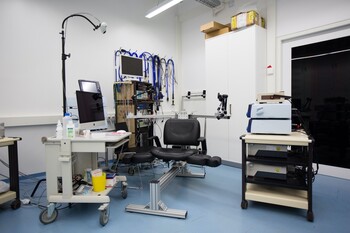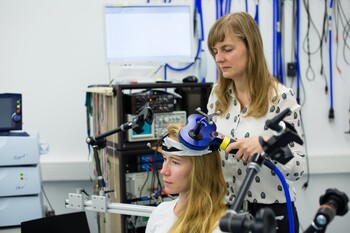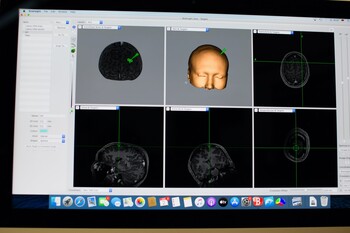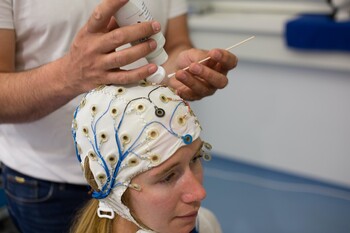Labore
Wir befassen uns vor allem mit der Physiologie der intrakortikalen und kortiko-kortikalen Konnektivität und Plastizität, der motorischen Kontrolle und der motorischen Entwicklung im gesunden menschlichen Gehirn. Mit Hilfe der transkraniellen Magnetstimulation (TMS) in Kombination mit einem Neuronavigationssystem (Brainsight), psychophysischen Verhaltensparadigmen, Elektroenzephalographie (EEG) und funktioneller Bildgebung (fMRT) verfolgen wir einen auf die jeweiligen Forschungsfragen zugeschnittenen multimodalen Ansatz. Zur Untersuchung der Induktion kortikaler Plastizität verwenden wir repetitive TMS (rTMS), transkranielle Gleichstromstimulation und kombinierte Ansätze.
In unserem Institut nutzen wir Labore für TMS, rTMS, transkranielle Gleichstromstimulation (TDCS), Elektroenzephalographie (EEG), verhaltensphysiologische und andere neurophysiologische Experimente, sowie den Forschungs-MRT-Scanner im Center for Brain, Behavior and Metabolism (CBBM).
Laboratories
We especially examine the physiology of intracortical and cortico-cortical connectivity and plasticity, motor control and motor development in the healthy human brain. Using transcranial magnetic stimulation (TMS) in combination with a neuronavigation system (Brainsight), psychophysical behavioral paradigms, EEG and functional imaging, we pursue a multimodal approach, adapted to the respective research question. To investigate the induction of cortical plasticity, we use repetitive TMS (rTMS), transcranial direct current stimulation (TDCS) and combined approaches.
In our Institute we use laboratories for TMS, rTMS, transcranial direct current stimulation (TDCS), electroencephalography (EEG), behavioral physiological and other neurophysiological experiments, as well as the research MRI scanner in the Centre of Brain, Behavior and Metabolism (CBBM).
Transcranial Magnetic Stimulation (TMS)
Transcranial magnetic stimulation is a technology enabling the stimulation and inhibition of areas of the brain by generating brief and strong magnetic fields. A magnetic coil, placed on the head above the target area induces a current in the brain that alters the activity of the underlying neuron populations. TMS can be used to induce magnetically evoked potentials which can be measured via EMG on a hand muscle. If a TMS pulse is given alone or paired with other TMS pulses over the same or different brain regions or paired with other pulses (such as electrical stimuli on the hand), it is possible to investigate the corticospinal and intracortical excitability and connectivity of brain regions. TMS can also be given in longer sequences (e.g. 1200 pulses at 1 Hz) in order to induce plastic changes and is then called repetitive TMS (rTMS). Thus, rTMS is a suitable tool in neuroscientific research for inducing cortical plasticity in specific brain regions.
Transcranial Direct Current Stimulation
Transcranial direct current stimulation is a non-invasive method for stimulating the brain. Through electrodes placed on the scalp, a current is induced, which alters the cortical excitability and neuronal activity. This stimulation modulates the activity of the nerve cells and leads, depending on the stimulation protocol used, either to an activation or inhibition of stimulated areas.
Electroencephalography
Electroencephalography (EEG) is a method of medical diagnostics and neurological research to measure the brain's electrical sum activity by recording voltage fluctuations via electrodes on the head surface. The EEG is the recording of such voltage fluctuations. The recorded signals can be analyzed in many different ways. In our research we are interested in event-related potentials that can be extracted from the EEG signals by averaging, but also in source localizations of cognitive processes.





